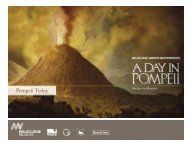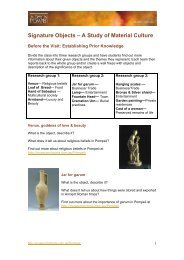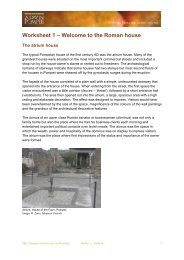Exhibition notes for A Day in Pompeii - Museum Victoria
Exhibition notes for A Day in Pompeii - Museum Victoria
Exhibition notes for A Day in Pompeii - Museum Victoria
Create successful ePaper yourself
Turn your PDF publications into a flip-book with our unique Google optimized e-Paper software.
http://museumvictoria.com.au/<strong>Pompeii</strong><br />
<strong>Exhibition</strong> Notes<br />
Roman temples were designed to house cult statues of the god or goddess to which<br />
they were dedicated; unlike most churches today, they were not usually entered by the<br />
worshippers. Instead, priests venerated the gods with processions and sacrifices on the<br />
altar, which stood <strong>in</strong> front of the temple. The Romans believed it was crucial to per<strong>for</strong>m<br />
these important rituals correctly, and the only way to know whether the god had been<br />
appeased was by div<strong>in</strong>ation, which meant exam<strong>in</strong><strong>in</strong>g the livers of sacrificial animals and<br />
the direction <strong>in</strong> which birds flew or how they ate <strong>in</strong> order to <strong>in</strong>terpret the god’s mood and<br />
<strong>in</strong>tentions.<br />
In addition to the public temples, most houses had a small shr<strong>in</strong>e or lararium, where<br />
daily ceremonials and rituals were per<strong>for</strong>med to appease the lares and penates who<br />
guarded the house. The lares (household gods) are usually depicted on these shr<strong>in</strong>es<br />
dressed <strong>in</strong> short tunics and carry<strong>in</strong>g dr<strong>in</strong>k<strong>in</strong>g horns and w<strong>in</strong>e buckets.<br />
As Rome’s empire spread, several new religions spread to <strong>Pompeii</strong> from overseas. The<br />
Egyptian cult of Isis was popular <strong>in</strong> <strong>Pompeii</strong> be<strong>for</strong>e the Roman colony was established <strong>in</strong><br />
80 BC, and appealed especially to the poor and oppressed, thanks to its story of death<br />
and resurrection and the promise of immortality. In the mythology, Osiris, the husband of<br />
Isis, is killed, and the tears of his griev<strong>in</strong>g wife cause the Nile to flood; however, her<br />
magical skills enable her to br<strong>in</strong>g Osiris back to life. When it was first discovered, the<br />
Temple of Isis at <strong>Pompeii</strong> was <strong>in</strong> exceptionally f<strong>in</strong>e condition, with most of the temple<br />
vessels and fitt<strong>in</strong>gs still <strong>in</strong> place. At the time of the eruption, the priests had tried to save<br />
the treasures of the temple, and the body of one of them was found next to a bag of gold<br />
near the Via dell’Abbondanza, (Street of Abundance).<br />
The Bacchic cult also became highly popular <strong>in</strong> this v<strong>in</strong>eyard-surrounded city, perhaps<br />
because it advocated extensive dr<strong>in</strong>k<strong>in</strong>g of w<strong>in</strong>e, which was thought to <strong>in</strong>duce religious<br />
ecstasy. One famous room <strong>in</strong> the Villa of the Mysteries depicts the god Bacchus<br />
<strong>in</strong>itiat<strong>in</strong>g members <strong>in</strong>to his secret society.<br />
Even a brand-new religion called Christianity found its way to <strong>Pompeii</strong>, perhaps along<br />
with the <strong>in</strong>flux of Jewish slaves to Italy after Jerusalem was sacked <strong>in</strong> 70 AD. At least<br />
some Bible stories seem to have been familiar to Pompeians; one <strong>in</strong>scription mentions<br />
Sodom and Gomorrah, and a pa<strong>in</strong>t<strong>in</strong>g <strong>in</strong> the House of the Physician shows a parody of<br />
the Judgment of Solomon with the characters depicted as dwarfs. A number of Semitic<br />
names have also been found <strong>in</strong> other <strong>in</strong>scriptions at <strong>Pompeii</strong>, <strong>in</strong>clud<strong>in</strong>g Jeshua, Jonas,<br />
‘Maria, a textile worker, and Martha, a slave’. Christianity was still young when <strong>Pompeii</strong><br />
was destroyed, but St Paul wrote dur<strong>in</strong>g his voyage from Malta to Rome <strong>in</strong> 62 AD, “… on<br />
the second day we came to Puteoli. There we found brethren, and were <strong>in</strong>vited to stay<br />
with them <strong>for</strong> seven days.” (Acts, 28:14). Puteoli is close to <strong>Pompeii</strong>, so it is possible that<br />
some Pompeians had also converted to Christianity, but no proof of this has yet been<br />
discovered.<br />
BURIAL PRACTICES<br />
The journey to eternity<br />
The roads lead<strong>in</strong>g out of <strong>Pompeii</strong> are l<strong>in</strong>ed with tombs, not <strong>for</strong> any om<strong>in</strong>ous reason, but<br />
because burial with<strong>in</strong> the city walls was not permitted. The best-known tombs l<strong>in</strong>e the<br />
road to Herculaneum. Be<strong>for</strong>e the Roman colony was established, Pompeians buried<br />
their dead <strong>in</strong> simple stone or brick cists (caskets or conta<strong>in</strong>ers), but after 80 BC<br />
cremation became the norm and wealthier Pompeians started to build more monumental<br />
8


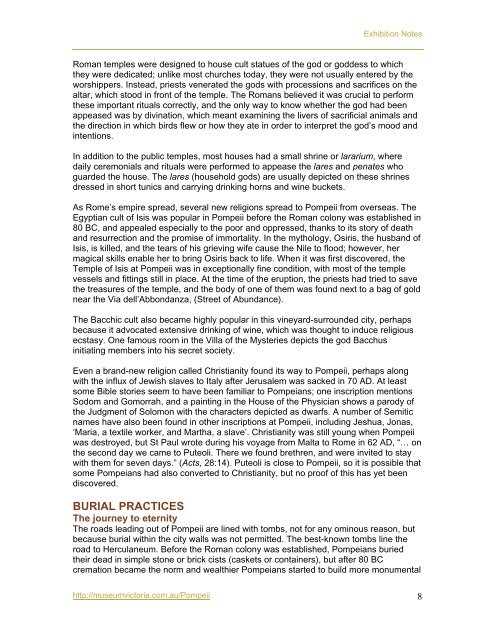



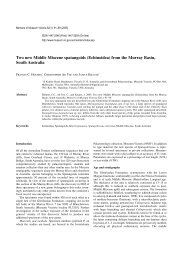
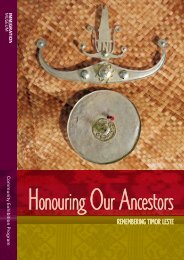
![[PDF] Andiamo a Pompei- Teacher Notes ... la - Museum Victoria](https://img.yumpu.com/16309810/1/190x245/pdf-andiamo-a-pompei-teacher-notes-la-museum-victoria.jpg?quality=85)

